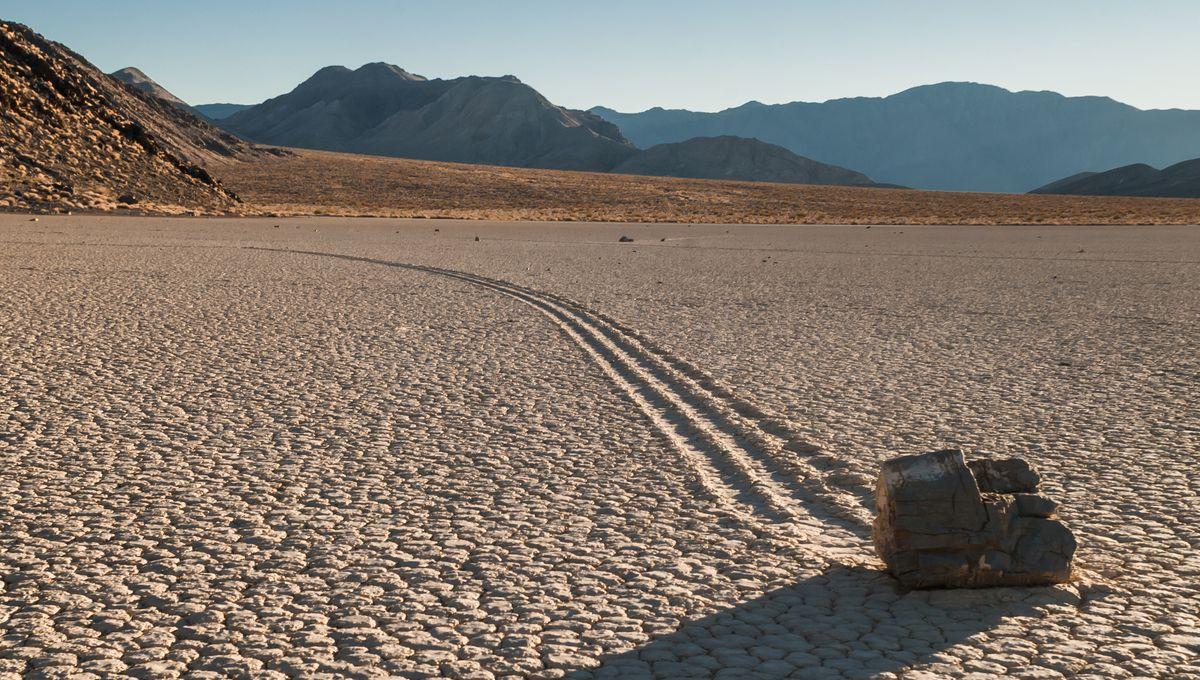Death Valley's "Racing Rocks" Inspire Experiment To Make Ice Move On Its Own

Death Valley's "Racing Rocks" Inspire Experiment To Make Ice Move On Its Own
For decades, Racetrack Playa in California’s Death Valley and its "racing rocks", or "sailing stones", was a mystery that inspired speculation ranging from epic storms to supernatural intervention. A decade after the movement of rocks across the desert floor was explained, their behavior has inspired a lab experiment that could one day see new methods of energy harvesting. The outcome has been somewhat different from what is seen on the playa, but the authors think their work could actually be more useful.
The rest of this article is behind a paywall. Please sign in or subscribe to access the full content. Racetrack Playa is littered with hundreds of rocks – the largest weighing more than two NFL linesmen – with zigzagging trails behind them indicating apparent movement across the desert floor. The rocks appear far too heavy and uneven to roll across the desert under the force of the wind, but other explanations were even more improbable. In 2014, Professor Richard Norris observed the rocks move when melting ice formed rafts that pushed them. Virginia Tech PhD student Jack Tapocik has used the idea to make self-propelled ice disks. The world is not filled with moving rocks because the behavior at Racetrack Playa requires an unusual combination of circumstances. The ground is flat enough that rare rains don’t flow away, and so hard water can’t penetrate the ground. Instead, a layer of ice forms across the playa at night. When sunlight comes, sheets of ice float on a layer of water a few centimeters deep. Having a much larger surface area than the rocks, these ice sheets catch more of the wind and become horizontal sails, concentrating enough force to make the rocks they run into slide over the wet ground. When the water drains away, the trail left in the mud becomes visible. The events only occur after heavy winter rains, which the valley only experiences every few years. Tapocik didn’t create an exact replication. Instead, he used an aluminum surface cut with herringbone grooves on which he placed a disk of ice. As the ice melted, it came to rest on a layer of water. A more important difference to the racetrack is that Tapocik didn’t provide an external force like the wind or sloped metal to move the ice. Yet move it did. “This directional flow of meltwater carried the ice disk along with it,” Tapocik said in a statement. “A good analogy is tubing on a river except here, the directional channels cause the flow instead of gravity.” Jack Tapocik with one of the ice disks he made self-propel using just its own meltwater and the grooves in the sheet it sits on. Image Credit: Alex Parrish for Virginia Tech Not everything in the experiment worked as Tapocik and co-authors expected. When the team sprayed the metal with a water-repellent coating, they thought the disk might move somewhat faster, but instead it originally remained stationary, before taking off at great speed. The team refer to this as a slingshot effect. “On a waterproof surface, the excess meltwater above the channels gets squeezed out very easily,” said senior author Associate Professor Jonathan Boreyko. “This makes the ice disk stick to the surface’s ridges. The meltwater is still flowing along the channels, but the ice can’t ride along anymore. The fun trick here is that as the meltwater flows beyond the front edge of the ice disk, it creates a puddle. Having a flat puddle on one side of the ice creates a mismatch in surface tension, which dislodges the ice and causes it to shoot across the surface.” The speed is much greater than that of the racing rocks, as well as having a different cause. Arguably, what was seen bears more similarity to the team’s other inspiration, the Leidenfrost effect, where drops of water race across a hotplate, floating on a layer of gas. Similar herringbone patterns have been shown to cause these droplets to self-propel, driven by the released gas. However, Tapocik and co-authors showed that the disk of ice can be much larger, and requires only a liquid-to-solid phase conversion, not for anything to turn to gas. Boreyko thinks the work could lead to a new source of energy. “If the surface structure were patterned in a circle rather than a straight line, the melting object would continually rotate,” he said. “Now imagine putting magnets on top of the ice, rather than boulders. These magnets would also rotate, which could be used for power generation.” Of course, that only works while the ice is melting. The energy required to cool the equipment to refreeze the ice would be much greater – probably orders of magnitude more – than could be captured from the disk’s spin, so this is not the path to a perpetual motion machine. Then again, nothing is. More practically, the authors argue this effect could be applied for “anti-icing systems, self-cleaning surfaces, and power-free microfluidic transport.” The study is published in ACS Applied Materials & Interfaces..jpg)


